ATTACKING WITH VERVE - CHESS FOR THE DIGITAL AGE
BETTER THAN AN ACTION MOVIE
They have shuffled their tiny wooden pieces back and forth, Vladimir Kramnik and his challengers at the World Championship 2007 at Mexico-City. But maybe the way tournaments are still decided these days - by using child-like miniatures on solid boards - will strike future generations as having been strangely old-fashioned at the beginning of the 3rd millennium. Whilst professional chess players still pay tribute to tradition with regard to the hardware of the game by sticking to centuries-tested wooden stuff, creative minds are already working on designing innovative versions of chess that do better fit to the digital age. Canadian Dave Potter, a 58-years-old IT-consultant from Toronto, has invented a thrilling PC-version of chess called VERVE. Its main features: You see the theatre of operations through the virtual "eyes" of your chessmen. Consequence: some parts of the terrain remain invisible to you. Moreover, VERVE introduces an element of "real time"-action into chess. DAVE POTTER who has learned chess at the age of 10 explains the revolutionary way that makes you discover the hitherto unknown potential of that ages-old game of chess, see the webpage www.vervechess.com. The VERVE CHESS-man answers questions that have been posed to him by the author Dr. René Gralla from Hamburg, Germany. Excerpts:
(photo: courtesy by D.Potter)
DR. RENÉ GRALLA: Many people consider chess to be very difficult: They
stare at board and pieces, but they do not "see" anything. But right now
here you come with VERVE CHESS, and that will make things probably worse
for many people. Conforming to the rules of VERVE CHESS a player only
sees certain sections of the board depending on the visibility of his
pieces. Don't you see the danger that chess can simply become
un-playable for all too many people if they try to play it by the rules
of VERVE CHESS?
DAVE POTTER: VERVE does introduce new challenges. Some of these are also
present in bridge, and I think that we can see from the success of
bridge that players can handle and indeed love those challenges: the
challenges of discovery, deduction and probabilistic reasoning, and of
concealment, deception and surprise. Another challenge relates to
VERVE's real time play feature. This challenge is not found in any other
game, and I am sure that players will find it interesting and enjoyable
as well. It is based on an ongoing trade-off between initiative and the
availability of information. This trade-off constantly tests players'
strategic judgement - they have to move at a rate that best balances the
two. If they move too slowly, they concede the initiative too readily to
their opponents. But if they move too fast, they give up too much
information. Yes, it will take new players some time to become
proficient at VERVE, as it does with bridge or with chess itself. But
like those games, VERVE delivers fascinating challenges in return.
DR. R. GRALLA: The phenomenon of being "blind at chess" is well known -
and dreaded. The player ponders a given situation; he checks out the
pieces and their positions on the board. In the pure physic sense she or
he is capable to recognize and assess everything - and yet she or he
overlooks that the ominous square where she or he is is about to place a
chessman is actually controlled by an enemy fighter. Thus, by
overlooking that simple threat, the ill-fated piece gets primitively
snatched away by the opponent. Now, with chess being played conforming
to the new rules of VERVE CHESS and due to the reduced visibility in the
scenario of VERVE, one can fairly assume that the number of cases like
the one that has been described in the foregoing will probably increase,
bearing the consequence that the quality of chess play will inevitably
deteriorate. Taking the foregoing into account: What is the point of
inventing - and promoting - VERVE CHESS?
D. POTTER: First, let me explain about hidden information in VERVE.
Players see the board through the eyes of their men. They can see the
squares their men can move to, and some other squares in addition. This
lets them see quite a lot of the board. They should also be able to
deduce quite a bit about the opposing position. In dealing with
remaining uncertainty, they naturally try to choose moves with the
highest chance of success. As in bridge, really good players will be
able to play almost as well as if they could see the whole board. In the
example you mention, the eventual loss of an important piece to the
unseen unit of the opponent may have been a blunder. But it is also possible
that the player did in fact make the best possible play based on
probabilities. It happens all the time in bridge that the percentage
play does not work out. Or maybe the loss resulted from rash play, which
still was not an out-and-out blunder. So why promote VERVE CHESS? Well,
I think people will enjoy the challenges I mentioned earlier.
DR. R. GRALLA: Not only amateur players but even great masters committ
blunders. See the most recent black-out by World Champion Vladimir Kramnik
running head on into a sensational checkmate in one during his match
against the German computer program "Deep Fritz" at Bonn in late autumn
2006. You are not afraid that VERVE CHESS will lead to matches that are
just a chain of goofs and blunders?
D. POTTER: VERVE is a sophisticated game that poses a strong challenge.
In any such game, blunders will occur, even occasionally by the
strongest players.
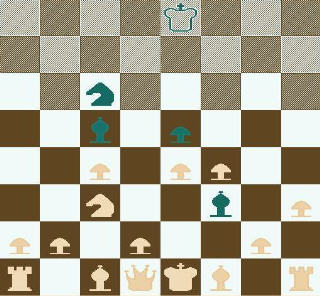
Incoming units that are riding on diagonals which can be traced back to some positions well beyond the horizon of the duellists are rather difficult to detect in the scenario of VERVE. A typical situation after the moves: 1.e4 e5 2.f4 Bc5 3.Nf3 d6 4.c4(??) Nc6 5.Nc3 Bg4 6.h3? Bxf3. That situation - diagram: D.Potter - that has been played in standard chess some years ago has now been transformed conforming to the rules of VERVE, and the resulting diagram demonstrates that White can only notice that ominous gap on g3 and h4 that could be the harbinger of disaster. If that match would have been VERVE CHESS the mishandling of the defence by White would have been quite understandable: 7.gxf3 Qh4+ 8.Ke2 Qf2+ 9.Kd3 Nb4# 0:1 (Ulrich W. Schmidt vs. Dr. René Gralla, 5-Min.-Blitz competition, June 18th, 2003; Hamburg, Germany, Café "Zumir").
DR. R. GRALLA: What has triggered the start of your project VERVE CHESS?
D. POTTER: When I bought my first Apple II computer in the early 1980s,
I thought that personal computers could allow games that were previously
not practical. Computers could go beyond the limitations of boards,
counters, cards dice and so on. The two capabilities of computers that
most impressed me were their ability to selectively reveal information,
and their ability to deal with events in real time. Traditional board
games involving hidden information were limited, typically using awkward
mechanisms like inverted counters and screens. And there were no real
time board games at all. I started thinking about what chess would be
like with incomplete information and real time play. Incomplete
information was easy. The mechanism seemed intuitively obvious - pieces
should be able to see along their movement patterns. And the value was
also clear - hidden information would provide the same challenges in
chess that it does in bridge. Real time play was more intriguing.
Without the alternating move, how could the game still be chess? What
would stop players from just moving as fast as possible? And most
important, what intellectual challenge would real time play pose? I
found these questions fascinating. Early on I had preliminary answers. A
weaker version of the alternating move would preserve chess tactics and
endgame techniques, while still allowing for meaningful real time play.
And a trade-off between initiative and the availability of information
would stop players from moving too fast. That trade-off would also
provide the key challenge of real time play. But it took several years
to refine these answers and bring all of the elements into balance.
DR. R. GRALLA: How long have you worked on realizing your concept of
VERVE CHESS?
D. POTTER: I have been gradually developing the concept for about 25
years. But I only began serious programming work on it about four years
ago.
DR. R. GRALLA: Your current rating in tournament play?
D. POTTER: I am just a recreation player, so I do not have a rating.
DR. R.GRALLA: Your project is called "VERVE" CHESS? Has that name
something to do with the concept of VERVE?
D. POTTER: "Verve" means a spirit of daring and boldness. Players should
be daring in the face of uncertainty and real time pressures. They
should play the game boldly, with verve.
DR. R. GRALLA: So let's now have a closer look at the intricacies of VERVE CHESS.
When I am pondering whether to move a given Bishop or not, just to name
one example, then there will be visible on the screen only those squares
of the diagonal where that officer can move?
D. POTTER: Not just the Bishop. You can also see all of the squares that
any of your other men can move to. Plus: you can also see a surrounding
envelope of diagonally adjacent squares.
DR. R. GRALLA: To make sure that I have got it correctly: Can the Bishop
"see" - apart from those squares where the Bishop is allowed to move to
diagonally - those adjacent squares as well that are laterally the
nearest ones?
D. POTTER: No.
DR. R. GRALLA: Why that distinction with regard to the envelope of
diagonally adjacent squares - that are visible - and laterally adjacent
squares that are not visible?
D. POTTER: My original idea was that men would see just where they could
move. But it seemed that there was too little information available,
both in general and in two specific situations. First, you could not
necessarily see enemy Pawns guarding the squares you might want to move
to. Second, during a basic winning endgame, you could not see the enemy
King well enough to force a win.
So I expanded on the field of vision of the pieces
by adding a surrounding envelope of all adjacent squares. But
then it seemed that there was too much information available. So I
settled on including just diagonally adjacent squares. This is enough to
address the two specific situations mentioned above, and it seemed to me
to achieve about the right balance of information availability.
DR. R GRALLA: The concept of reduced visibility in VERVE CHESS seems to
be the adaption of the subjective camera that we know from the cockpits
of racing cars. What are the consequences of that if we refer again to a
Bishop on his diagonal? The Bishop is sitting there, but at a distance
of three squares further on that given diagonal there is hovering the
big body mass of an enemy Queen - or a friendly Queen. Beyond that
blocking piece the diagonal continues, so what can the Bishop see? And
how far can that long-range unit "see"? Does the Bishop's field of
vision stop at the blocking piece on the diagonal? Or can the Bishop
make out those squares behind that blocking piece too?
D. POTTER: The subjective camera thought is an interesting way of looking
at it. I had not thought of it that way, but it is a very apt analogy.
As for the blocking of visibility, in the example you give, the field of vision of the Bishop
stops at the Queen and no further squares are visible.
For a friendly Queen, the envelope of diagonally adjacent squares around
the Queen is visible. For an enemy Queen, it is not.
DR. R. GRALLA: So the concept of reduced visibility on the board
conforming to the rules of VERVE CHESS is more of a mathematical quality
and scope rather than being based on a quasi-realistic approach to the
game?
D. POTTER: Yes. I was aiming at consistency with chess rather than
realism. So, just as the Queen blocks the move of the Bishop, so it blocks the field of vision of
that very Bishop.
DR. R. GRALLA: Many matches in chess start with the classic move order 1.e2-e4 e7-e5. How far can White see after that?
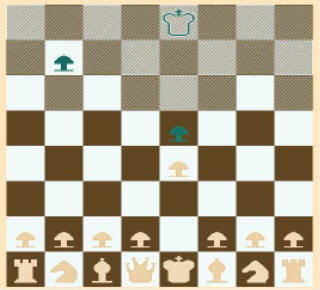
Screenshot of VERVE CHESS after 1.e4 e5: The bulk of Black Army remains unvisible (diagram: D.Potter).
D. POTTER: White can see everything that all of the chessmen of the White Army can recognize, not just the King's Pawn that has moved from square e2 straight on to square e4. All squares to the 5th rank are visible to the Pawns: their double move lets them see to the fourth rank, and their envelope of visibility extends that up to the fifth rank. The Bishop f1 can see along the diagonal f1 to a6, and so adds a6 to what can be seen, and also c6 and b7 as part of the Bishop's envelope. The Queen can see along the diagonal d1 to h5, and so adds h6 because it is part of the Queen`s envelope. The "hollow" symbol of enemy King is a player aid that marks the last known position of the enemy King. If e8 were visible, the symbol of enemy King would be solid, not hollow.
DR. R. GRALLA: That "hollow" symbol of King is rather cryptic. What can I
conclude from the "hollow" symbol of enemy King? Does it depict the
result of the move before the last move of enemy King?
D. POTTER: This is not the correlative to anything on the "board" of
virtual reality, and you can draw no special conclusion from that. On
the player's display it is just a notation to remind him or her where
enemy King was last seen. At the beginning of the game, right after 1.e4
e5, it is shown over e8, even though Black King is not visible there
and never was, because we know that there it is, the starting-out
position of Black King.
DR. R. GRALLA: Why have you chosen to depict that position by that hollow
symbol?
D. POTTER: It's just a player aid, trying to make the game a bit easier
to play by helping the player to remember a key fact.
DR. R. GRALLA: Apart from the envelope of diagonally adjacent extra
squares that a piece can see - in addition to those squares that the
unit can move to - your army can recognize that the enemy King is
in check, maybe, or that he is closely blockaded or that he is guarding
a square to which one could move a closely blockading man. Why those
extra squares that are visible?
D. POTTER: As mentioned above, these extra - diagonally adjacent -
squares are visible to allow you to enforce checkmate in a simple
endgame. For example, with White King and Rook against Black King, if
your Rook is on the sixth rank and the enemy King is on the seventh
rank, then you can see it: White Rook sees along the sixth rank because
it can move there, and it can see the whole seventh rank because those
squares are all diagonally adjacent squares to squares on the sixth
rank.
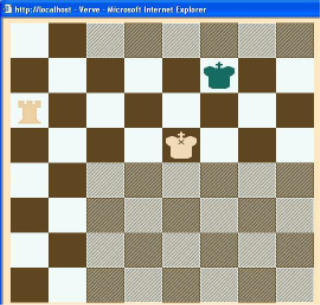
Screen capture showing what a Rook can see as it closely blockades the enemy King. The brighter black and white squares are visible to the Rook and the duller coloured ones are not. White King has an X over it, indicating that White King is unable to see, having moved recently (diagram by D. Potter).
DR. R. GRALLA: What about a situation when your own King is in check, but
the attacking chessman of your opponent is well beyond the horizon of
the HQ of your army. Can you realize that your King is threatened? From
the practic point of view one should be capable to detect that one's own
King is checked, since that could be decisive for the outcome of the
match, of course.
D. POTTER: You may not know if your King is in check if you cannot see the
checking piece. You are correct that an attack like that is of great
importance. If you cannot see that you are in check, you might try to
make a move that is illegal because it does not escape check. Illegal
move attempts are very costly. You have to pay an information penalty
and wait 30 seconds before trying again. And if you do not find a legal
move within four minutes of your last legal move, you lose.
DR. R.GRALLA: Your concept of VERVE CHESS seems to be a modern adaption
of "Kriegsspiel": that version of chess that the former German World
Champion Dr. Emanuel Lasker has once advocated. Nowadays it is Professor
David H. Li from Bethesda, Maryland who has published an in-depths study
on "Kriegsspiel". The basic idea of "Kriegsspiel": You can not see the
army of your opponent; you are fighting the enemy troops by just
guessing where they have dug in, therefore you need an arbiter at the
board who keeps track with your operations and the maneuvers of your
opponent and who tells you whether you have hit the enemy or whether you
have been hit by unfriendly fire. So VERVE CHESS - which operates with a
reduced field of vision at least - is a less radical concept than
"Kriegsspiel" where there is zero visibility for both sides.
D. POTTER: Yes. VERVE makes a lot more information available than
"Kriegspiel" does, so it is much more similar to chess - and in that
sense less radical.
DR. R. GRALLA: It seems to me that VERVE CHESS is closer to reality than
"Kriegsspiel". VERVE simulates the situation that the opponent resorts
to partly concealing the movements of his troops by producing artificial
"fog" - well, kind of - , since you can not keep track of every single
unit of the opponent's army, on the one hand. But on the other hand you
can make out at least some of the enemy troops, and that is the usual
case in hot warfare too. In the theatre of operation of the digital age
it is hardly thinkable that you can camouflage a whole army.
D. POTTER: Realism was not my inspiration for VERVE. But like standard
chess and "Kriegspiel" it can be considered to be an abstract model of
war. In that sense VERVE is more realistic than "Kriegspiel" in its
modelling of the fog of war because it makes a lot more information
available, as it is the case in real war. It is also more realistic than
"Kriegsspiel" because VERVE models the real time nature of war by
including the key element of real time play which "Kriegspiel" does not
know. In that sense VERVE is even more radical a concept than
"Kriegsspiel".
DR. R. GRALLA: That leads us to a historic and cultural excursion. Have you been inspired to create VERVE CHESS by the ancient chess variants of Burmese "Sit Tu Yin" and Ethiopian "Senterej"? In Burmese Sit Tu Yin you can only see the frontline of Pawns at the beginning of a match.
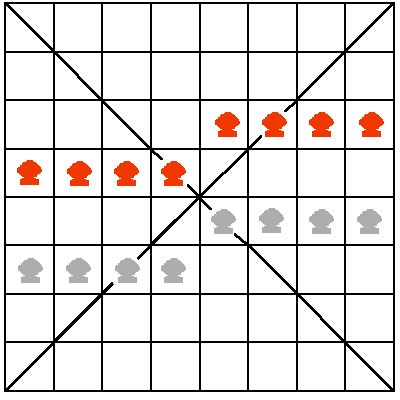
A curtain drops down between the opposing lines of the infantry of both
armies, and - concealed by that veil - the adversaries place their units
where they assume that those are the best places to plunge right into
action. Then the curtain will be raised - and only now the players can
see where their opponent has deployed his troops. Ethiopian Senterej has
adopted the rule of moving independently at the beginning of a match.
During the mobilization phase - called "Werera" - every player moves the
pieces just as she or he likes to do so, until the moment when the first
unit will be annihilated or the first chessmen will be exchanged. After
that the moving rules of standard chess apply again. Have you been
inspired by Burmese Sit Tu Yin and Ethiopian Senterej before creating
VERVE CHESS?
D. POTTER: No. I was not aware of those games.

DR. R. GRALLA: Back again to the possibility of moving VERVE
CHESS-pieces in real time: What happens when a piece of mine is taken?
Am I obliged to react - or can I just go on pursuing alternate plans of
staging an attack on my own?
D. POTTER: There is no obligation to react. But you are guaranteed the
right to react if you like - your opponent has to give you 30 seconds to
respond before moving again.
DR. R. GRALLA: What about a check on my own King? Then I am forced to
react, one might guess.
D. POTTER: Yes and no. Of course you do have to get out of check at your
next move, as in chess. But you do not have to make that move right
away. And if your opponent moves before you do, he might remove the
check himself. Not very likely, but possible in theory. As I have
mentioned earlier, you have to get out of check within four minutes of
your last legal move or you lose. So this requirement is very
significant.
DR. R. GRALLA: In the orthodox version of the game there is an iron rule:
As soon as you have been checked you have to do something about that,
either by leaving the danger zone or by doing something else, say, by
killing the attacking chessman or by blocking him at least. You can not
move on whilst your King is in check. But in VERVE CHESS that seems to
be possible if we have understood you right?! If my King is checked but
not check-mated I can leave the monarch on that very square where the
commander-in-chief is checked - as long as the King is not check-mated -
since it would be illegal to snatch away the enemy King ?!
D. POTTER: No, it is like chess in that you can't make a move leaving
your King in check. All you can do is wait, hoping that your opponent
will move first. But your opponent does not have to move first, and if
he or she waits long enough, it is you who has to move first. The reason
is that you have to make a legal move at least every four minutes, and
your opponent made the last legal move to put you in check. So your four
minute time limit expires before theirs. So, if your opponent wants,
they can make you move first. Therefore, if your opponent wants it to be
exactly as in chess, it is. In that case, you have to move first, and
you have to escape check.
DR. R. GRALLA: Would you please elaborate on that a little bit more ...
D. POTTER: ... the motive for the rule is in fact to be as consistent
with chess as possible. In chess you can't capture the King, so not in
VERVE either. And in chess you can't make a move that puts you in check
or leaves you in check, so not in VERVE either. For meaningful real time
play, you do have to be in control of when you move, so you are not
forced to move right away. But in chess,after your opponent moves you
have to make the next move. So in VERVE you do, if your opponent forces
you to do so. The rule that lets your opponent force you to move in turn
is the four minute limit.
DR. R. GRALLA: Why letting the player try to keep on playing anyway after
his King has been checked? There could be a more logical rule for that:
After your King has been checked and you have ignored that by
nonchalantly doing something else, then your cocky way of ignoring the
check would be penalized by declaring your move to be illegal. And you
will have lost the game at once.
D. POTTER: Well, you can't keep on playing without escaping check. The
rule you suggest is in fact what VERVE does use, except that you don't
lose the game on your first illegal move try. You get to try as often as
you can within the four minutes from your last legal move - but only one
try every 30 seconds.
DR. R. GRALLA: VERVE CHESS is chess as a kind of real time battle game,
with White Army and Black Army operating independently. One has not to
wait after one's own move for the adversary to react until one is
allowed to deploy one`s units again. What is the consequence in a
situation of imminent check-mate? Let's think of looming disaster: I am
about to have committed Seppuku, on the chess-board virtually, because
my opponent can finish my King off by just one stroke. Provided, I have
realized that only after my fatal black-out, but before the adversary
has become aware of that big chance: Do the rules allow me to react
swiftly by moving once more again in order to neutralize the otherwise
deadly attack on my King?
D. POTTER: You do have to give your adversary 30 seconds to react to your
last move before moving again. That rule is needed because it provides
for tactical consistency with chess. It means that in an exchange, for
example, players will alternate moves, provided of course that they see
the moves of each other. So the answer to your question depends on whether
your opponent reacts within 30 seconds. If he or she saw your move, they
probably will react, and there is nothing you can do to avoid checkmate,
as in chess. But after 30 seconds, you can make another move to escape.

Check-mate is imminent - but is Black aware of that? The screenshot - line of sight from the HQ of Black Army direction White (wearing red uniforms in this case) - depicts a tense situation after the initial moves 1.e4 e5 2.Nf3 Nc6 3.Bc4 f6? 4.Nh4! ... . What can the defending side recognize if that match is a duel in VERVE CHESS? Black can see: all of ranks 8, 7, 6, 5 and 4 - because of the visibility enjoyed by the Black Pawns, even without considering the other men - ; the positions e3, c3, a3 - because of the view that the Black Knight enjoys from its square c6, and c3 and a3 are visible because of the view by Bishop f8; the square b2 - because of the view by Bishop f8. But the rest of Red Army is camouflaged by fog, with the exception of the attacking King as a kind of reminder where the monarch of the enemy has been located lately. Therefore the deadly threat is not easy to discover: that fatal blow via diagonal h5 to e8. The actual match - that has been staged with full view of the board, however - has been continued as follows: 4. ... Bc5?? 5. Qh5+ Kf8 6.Qf7# 1:0 (Dr. René Gralla vs. Ulrich W. Schmidt, August 5th, 2004, Hamburg, Germany; 5-min.-blitz, Café; "Zumir"). That match has been a 1:1-replica of Nibal Al Jindi (Syria) vs. Adeela Raweh (Yemen) on October 28th, 2000, during the 10th circuit of Chess Olympia Istanbul, women's competition. Photo: Christoph Harder.
DR. R. GRALLA: In VERVE CHESS there is no more being fixed to the ground
like the poor rabbit being immobilized by facing the killer snake? After
having one's King letting walk into the final trap? Since there is still
the option left to react - provided there is still an option to react?
D. POTTER: Or only for 30 seconds anyway.

Unknowingly she has contributed to the theory and practice of VERVE CHESS before that futuristic version of the eternal game has even been invented: Adeela Raweh, female top athlete from Yemen who fought for the colours of her country at the Chess Olympiad Istanbul 2000 (photo: www.chessbase.com).
DR. R. GRALLA: Consequence: There are more chances to repair blunders in
VERVE CHESS? Is that a kind of compensation for the fact that boo-boos
are more likely in VERVE CHESS?
D. POTTER: Well, as I have mentioned earlier, I do not envisage that many
blunders occurring, but I guess you could look at it that way.
DR. R. GRALLA: Taking the foregoing into account the execution of
checkmate seems to be more tricky in the scenario of VERVE than in
standard chess. Only two alternatives are thinkable: either to create a
situation where there is no defence anymore, or to menace a frugal
check-mate and to react very fast then.
D. POTTER: Does the second method envisage capturing the King before it
can escape? If that is what you mean, then no, you cannot do that. As in
chess the King cannot be captured. If you have your opponent in check
but not checkmated, then after waiting 30 seconds you are free to make
other moves, for example to achieve checkmate or at least reduce the
number of ways the King can escape, or to capture another man or
otherwise improve your position. But you cannot capture the King.
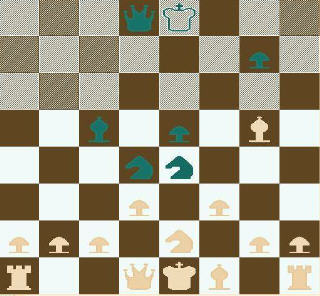
DR. R. GRALLA: Sophisticated combinations - heavy sacrifices of material
including - with the purpose to enforce check-mate upon my adversary get
more complicated and risky then. Many combinations are based on the
principle of action & reaction & action & reaction, and it looks as if
that rule does not work too well in VERVE CHESS, as consequence of the
real time feature.
D. POTTER: I do not agree. The principle of action & reaction is still
valid in VERVE, because you need to give your opponent 30 seconds. And
he or she has to give you 30 seconds after reacting. So, in tactical
situations, the moves do alternate, that is, there is action & reaction
& action & reaction.
DR. R. GRALLA: The real time modus in VERVE CHESS, that is to say, the
possibility of the opponents to maneuver independently, instead of those
alternating tit-for-tat-moves in standard chess, opens up a new
dimension for chess. By the innovative concept VERVE CHESS combines the
distinctive traits of the two members of the family of strategic games
that we know today: chess - where moves are alternating - and strategic
games on the PC where duels are fought in real time.VERVE CHESS combines
the best of those Two Worlds ...
D. POTTER: ... that captures very nicely the inspiration behind VERVE -
to take advantage of the capabilities of computers by introducing real
time play and restricted information, but still in a way that remains
true to chess. The only qualification I would make on your statement is
to emphasize that VERVE CHESS is more abstract than most strategic games
on the PC. In fact, the trade-off between initiative and information at
the heart of VERVE is quite different than anything in any the PC games
that I am aware of.
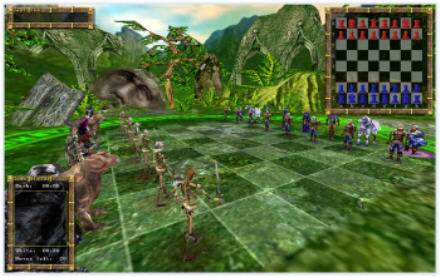
Chess meets strategic gaming in the virtual world: Screenshot from KOZMO GAMES-release "WarChess" in 3D (photo: courtesy by KOZMO GAMES).
DR. R. GRALLA: Please explain to us the modification that you have just
mentioned: that "trade-off between initiative and information". We learn
that VERVE CHESS implements a trade-off between initiative and
information: All moves are designed to cost information, and the loss of
information increases dramatically as the player moves on too
quickly.Please explain that irritating provision to us.
D. POTTER: This trade-off is very important. It is the mechanism that
makes real time play challenging. It works as follows: When a chess-man
moves, it temporarily loses its vision. The time it takes to recover its
vision increases dramatically as a player moves more quickly. If a
player moves too fast, several chess-men will soon be unable to see for
long periods of time, and so much less information will be available to
the player. This trade-off involves strategic judgement: A player who
moves too quickly or too slowly gives his or her opponent a significant
advantage. There is an exact formula for that rule as follows: When a
man moves, it loses its ability to see for 22n-t-10 minutes, where n is
the number of moves you have made, including the current one, and t is
the time at which you move, in minutes since the beginning of the game.
If the chess-man was already unable to see, the time it will take to
recover its vision is extended by that amount.
DR. R. GRALLA: Why that loss of information when a player is playing too
fast? Normally one should get more informations by the strategy of
blitzkrieg - since one's army is supposed to know more positions on the
battle-field the swifter your units get deployed there!
D. POTTER: Yes, you do gain information - in the long run - by moving
your men to squares from which they can see more. But you lose - in the
short run to medium run - because your men lose their sight for a while.
And the faster you move your chess-men the longer they will lose it for.
DR. R. GRALLA: All right, obviously that is the VERVE way of simulating
the effects of the exhaustion of the soldiers after having stormed
against the enemy incessantly. In any case VERVE CHESS has the potential
to persuade gamers - who otherwise tend to think that chess is boring -
to try out chess again.
D. POTTER: VERVE's target audience does indeed go beyond serious chess
players. It will also attract recreational players, people who enjoy
chess variants, and yes, those who are not currently active players and
who might be brought back to the game by new challenges.
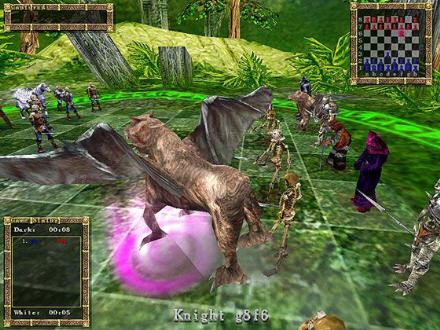
Targeting a new audience for an ages-old game: action chess by KOZMO GAMES (screenshot from "WarChess" ; photo: courtesy by KOZMO GAMES).
DR. R. GRALLA: Maybe VERVE CHESS can have a nice and unexpected
educational aspect, namly to tackle the problem of game addiction in the
sector of PC-games. Since VERVE CHESS - being played in real time - is
close enough to PC-battle games to be attractive even for the hard-core
gamers. And if they switch to VERVE CHESS, then they will have switched
to a game that has an undisputed cultural and educational value.
D. POTTER: Yes, some of the play testers who have enjoyed VERVE the most
have been PC games enthusiasts. VERVE has a strong potential to
popularize chess, particularly among people who enjoy other PC games.
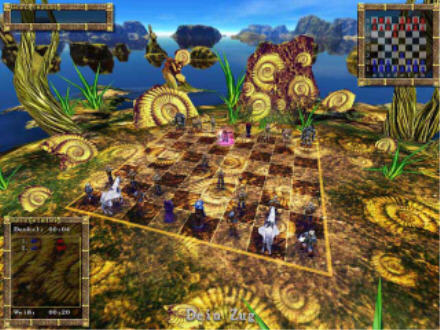
Potential to popularize chess? Showdown in paradise (screenshot from KOZMO GAMES' "WarChess" ; photo: courtesy by KOZMO GAMES).
DR. R. GRALLA: Chess has a communication problem. It is full of
adventure, but nobody can see that - apart from the players. Can VERVE
CHESS be a way to make chess more attractive for onlookers? By
introducing those elements of surprise just as in sports coverage: both
armies operating independently in real time, enemy troops that are
bursting into the theatre of operations just out of the blue - because
you have not seen them before?! And there is this subjective camera:
looking at the board through the eyes of your men - so you are getting
right into the action, just like in great action movies. So by employing
that kind of chess coverage that is the trademark of VERVE CHESS, your
innovative version of chess could even trigger a revolution with regard
to chess coverage - since every match of VERVE CHESS rolls on like a
real action movie.
D. POTTER: In some ways VERVE CHESS can be even better than a movie,
because it can allow the game to be viewed from the perspective of
either player or from a full-information point of view. People could
switch back and forth to replay specific game events from all three
perspectives.
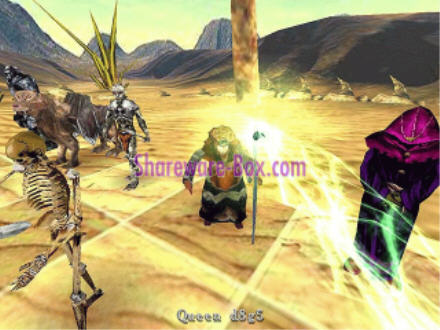
Better than an action movie: conquering the desert plane by mate attack (screenshot from KOZMO GAMES' "WarChess" ; photo: courtesy by KOZMO GAMES).
DR. R. GRALLA: Quite obviously VERVE CHESS has the potential to
popularize chess ...
D. POTTER: ... like bridge, VERVE can be played very seriously or just
for fun. And playing just for fun can lead to improving skills and
interest. Those who want to play well will of course study the
underlying principles of chess.
Webpage made: November 8, 2007.